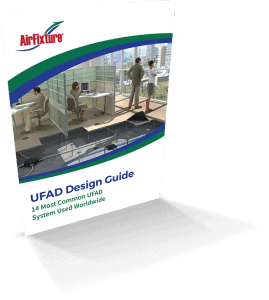Why UFAD & Raised Access Flooring Improves Lease & Rental Values
As a building owner, attracting and maintaining high-value tenants is critical for profitability. Installing a raised access floor system and ...
Floor, wall and ceiling mounted to meet your unique project design.
3 min read
Joe Hullebusch : Jul 17, 2018 12:00:00 AM

The global adoption of raised access floor (RAF) systems continues to rise, with a recent study estimating that the worldwide market for these installations will reach $1.5 billion by 2025. Designers and developers are reaping benefits ranging from dramatically reduced energy costs to improved layout flexibility, optimized slab heights, and - perhaps most importantly - improved air quality and occupant comfort levels which are a necessary hallmark for the coveted ‘green building’ designation.
Many of these benefits come from having an underfloor air distribution system (UFAD) as your main HVAC solution. While UFAD depends on a raised access floor, many buildings still use a traditional overhead air delivery system in conjunction with their RAF system. However, if you are one of the estimated 55% of buildings with RAF which aren’t taking advantage of UFAD, you’ll be missing out on several key advantages.
Here are four reasons why overhead air distribution is the wrong choice if you have raised access flooring.
As a building or facility owner, having a raised access floor system in place offers a fantastic opportunity to move bulky overhead ductwork to the empty plenum space under the floor. This setup allows you to reduce your energy costs by up to 30%.
For one, the absence of obstacles underneath a raised access platform means you can lay out your air distribution channels in a relatively straight line, reducing the amount of ductwork you’ll need to install. Since ductwork adds resistance to airflows, a traditional overhead system needs to use higher-powered fans to overcome this resistance. However, UFAD actually achieves 20% better ASHRAE 2.1 airflow effectiveness for less energy, requiring only 0.5 inches of static pressure to deliver airflow through the underfloor plenum.
Second, introducing airflow into an enclosed space at floor level means you’re only paying to condition the occupied zone. Since warm air naturally rises, you can let convective energy do the majority of the air delivery work for you. Conversely, an overhead system with ventilation diffusers placed at ceiling height has to work that much harder to force the rising air currents down to the occupied zone.
It’s well-known that UFAD systems can significantly improve both indoor air quality and thermal occupant comfort. Because air is introduced at ground level, occupants can have greater control over the delivery of conditioned air into their immediate zone, as opposed to overhead systems which ventilate from a greater distance from occupants. The air doesn’t need to be conditioned as much, resulting in a smaller temperature range that improves comfort. And because the raised access floor allows for the strategic placement of VAV (variable air volume) diffusers, drafts and cold spots can effectively be removed.
Also, this thermal displacement means that as air rises, it forces airborne particulates up and away from occupied zones where it can be filtered out, resulting in cleaner air and a more comfortable environment.
Since all building systems are routed through the underfloor plenum space, raised access floors eliminate the need for suspended ceilings, substantially increasing the available space within an enclosed area. In fact, this reduction in slab-to-slab height adds up to the point where it creates enough room for one additional storey for every 12, meaning that a building with raised access floors installed can have more floors within versus another of the same height using a conventional overhead system.
Finally, installing a raised access floor system means you have improved design and modular flexibility as compared to traditional flooring. Because of the modular nature of floor panel nodes - everything from electrical connections to air diffusers can be easily placed wherever they’re needed - occupants can easily move connections and add capacity as required. And since it’s easy to access, these components can be quickly updated and replaced as necessary.
As well, routing electrical and data wiring through the underfloor plenum provides a more direct line option to connect power and networking sources - giving you unrivaled ability to quickly reconfigure or upgrade your computing hardware while spending considerably less on the cables and wires themselves.
If you already have a raised access floor system in place, taking advantage of underfloor air distribution reduces your energy costs, improves building flexibility, and boosts indoor air quality and occupant comfort - maximizing your ROI while ensuring your building is environmentally sustainable for the future.
AirFixture is a recognized industry leader providing innovative underfloor air distribution products and solutions for office buildings, casinos, event spaces, and government facilities around the world. Contact us today to speak to a UFAD expert and learn how this revolutionary system can deliver unrivaled air quality and significant energy and operational cost savings to your facility.

As a building owner, attracting and maintaining high-value tenants is critical for profitability. Installing a raised access floor system and ...
Indoor Air Quality Directly Impacted by Floor Air Distribution

Building owners, facility managers, and commercial building tenants know the importance of keeping commercial HVAC running: If it gets too hot to...